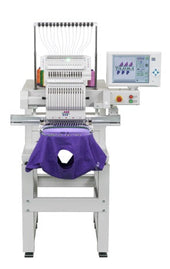Why does my sewing machine jam?
If your sewing machine keeps jamming in the middle of a project it can be frustrating. We all dread the moment when there is no sound and movement after pressing the pedal, and how your machine makes several stitches before getting tangled up during the project. The most important thing is being able to figure out the cause to fix it yourself and hopefully prevent further occurrences. Here are 5 reasons your sewing machine might be jamming.
Lack of tension on the upper thread
While you're sure the problem with the machine is most likely due to a huge amount of tangled thread in the bobbin under the fabric, the most common cause of a jam is usually not enough upper thread tension. This simple problem causes the machine to get stuck due to insufficient tension needed to pull the thread through the fabric you are sewing. All you have to do is raise the presser foot and re-thread the needle according to the manufacturer's instructions.
Your machine is clogged at some point or place
This may be due to dust, lint, or other debris getting inside the device. That's why it's important to set aside time periodically to clear the machine of stuck dust or dirt while working on various sewing projects. If such a jam occurs, turn off the stapler, proceed to remove it, and thoroughly clean the entire machine, in particular its working mechanisms. Use a small brush or blow off the fluff, dust, etc. Also, remember to regularly lubricate the metal parts of the machine for smooth operation. Use compressed air to blow all debris out of the heat exchanger area. To prevent this from happening in the future, schedule your machine to be cleaned and oiled monthly, and if you sew daily, you'll probably want to clean and maintain it even more frequently.
The needle is deformed or broken
Often your sewing machine suddenly stops working due to a bent or broken needle preventing the thread from passing through the fabric. Solution: stop work and carefully inspect the needle for deformation or breakage, and if you find any, replace it with a new one. Make sure you are using the correct type and size of needle for your machine as well as your specific project, as this can sometimes also be the cause of annoying sticking.
The feed dogs are not functioning properly
Another fairly common cause of sewing machine failure is when the small teeth located under the needle and presser foot that guide the fabric through the sewing process, also known as the feed dog teeth, are not working properly. The cause of the problem can be lint, dust and other debris stuck in their mechanism. Stop work, raise the presser foot, and thoroughly clean the feed dogs of debris. Also, make sure they are raised to an elevated position that provides sufficient tissue grip. Another useful thing to try is to make sure that the presser foot is not too low over the feed dogs, which causes problems with the free movement of the fabric during the sewing process. Adjust them properly before returning to your project.
Low-quality thread
Don't underestimate the quality of the thread you use for your sewing projects as low-quality thread can often cause several annoying problems for your machine and your project. Lower quality thread can cause lint to break down, which can get caught in the machine's mechanics and get stuck. In addition, poor quality thread tends to break and knot, which reduces the performance of your sewing machine and slows down and even messes up your project. Make sure you invest in quality filament of the type recommended by the manufacturer. This may cost more than lower quality filament, but it will ensure that your work is perfect and the machine is running at its best while you work on your next project.
If your sewing machine is in need of service or repair, contact us today.



